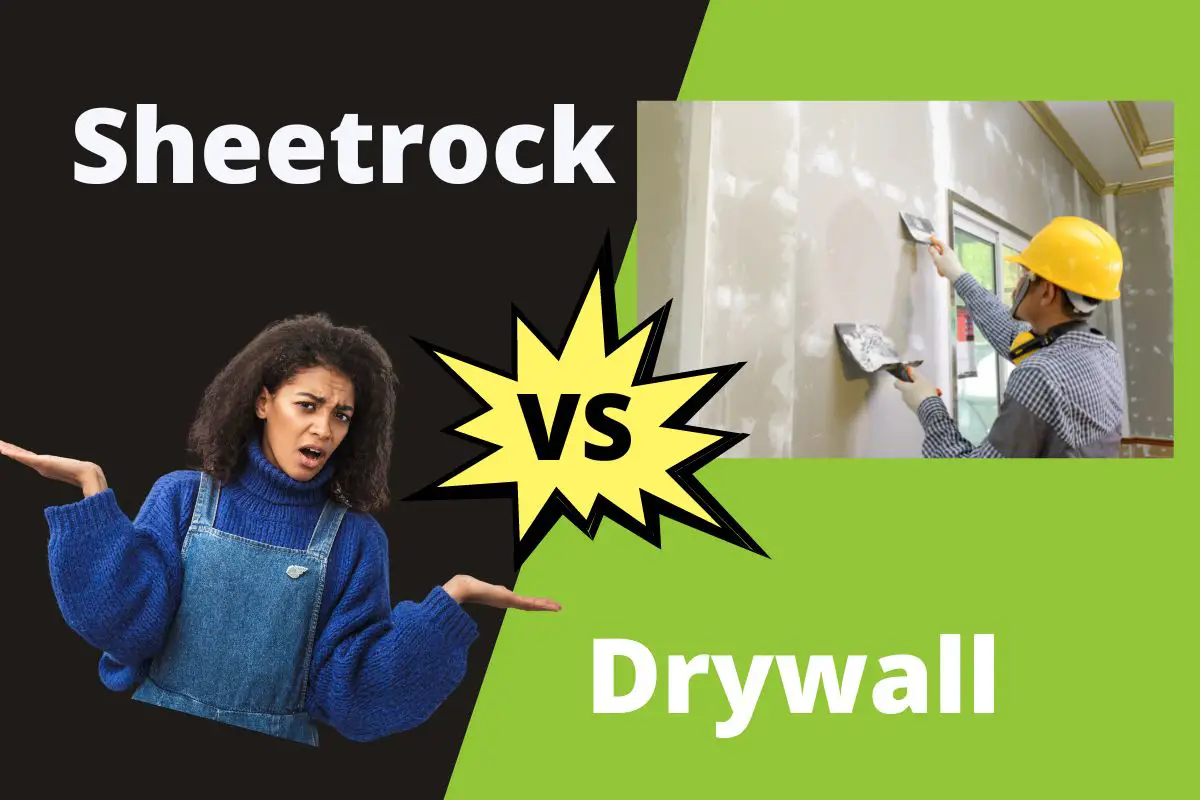Sheetrock and drywall are the same. Drywall is a smooth, large sheet of gypsum panels used in construction projects. Drywall is also called wallboard, plasterboard, buster board, custer board, etc. Sheetrock is a trademark or brand name for drywall.
Let’s take this further and see if there are any significant differences between the two.
Table of Contents
Sheetrock vs Drywall
| Sheetrock | vs | Drywall |
| Sheetrock is a trademark of drywall manufactured by USG | Type | Drywall is a construction material made from gypsum rock |
| 1901 by United States Gypsum Corporation | Invented in | 1894 by Augustin Sackett |
| Wallboard, plasterboard, gyprock, gypsum board | Other names | N/A |
| Ceilings, interior walls, basement walls, etc. | Usage | Exterior and interior walls, ceilings, etc. |
| Foil back, ultra code core, mold tough, fiber rock, sag resistance, abuse resistance, etc. | Types | Regular, fire-resistant, mold-resistant, water-resistant, soundproof, etc. |
What is Sheetrock?
Sheetrock is a drywall company. The United States Gypsum Corporation (USG) owns the trademark of Sheetrock. The company was formed in 1901, and to date, it is one of the top companies making drywall panels worldwide.
Due to the popularity of Sheetrock, people started using the names Sheetrock and drywalls interchangeably. But only the USG can use the name Sheetrock for marketing their panels.

What is Drywall?
Drywall is a smooth panel that gives interior walls an excellent finish. Drywall is made from gypsum rock, a naturally occurring mineral from calcium sulfate.
Manufacturers turn gypsum rocks into gypsum powder and use it as a replacement for traditional lath and plaster. Drywalls may have other additives like fiberglass mats depending on various types.
Drywall is made by pressing the paste between two sheets of paper, making the drywall panels moisture and fire-resistant.

Difference Between Sheetrock and Drywall
There isn’t a significant difference between the two. As previously mentioned, both are gypsum panels or drywalls.
General vs Specific
Drywall is a general term for plasterboard, gypsum board, or wallboard. In contrast, Sheetrock is a trademark of a particular drywall brand.
Numerous drywall brands make these gypsum boards, but only USG can name their drywall board Sheetrock. In short, the U.S Gypsum Company owns the trademark of the Sheetrock brand.
Origins
Augustin Sackett invented drywalls in 1894, and earlier, it was called Sackett board after his name. Before the invention, people applied plaster on wood lath in interior walls, which took a long time to dry.
The gypsum boards Sackett invented replaced the plaster, and they were also quick-drying. Due to this, people later named these panels drywalls, which immediately became popular after World War II.
Sheetrock, on the other hand, entered the market in 1901. The United States Gypsum Corporation introduced gypsum panels after merging a few small corporations that also made construction materials.
Manufacturing Procedure
The manufacturing does not vary much since both are Sackett boards. Still, the USG uses special chemicals that set their gypsum boards apart from other manufacturers.
Mentioned above are the critical differences between Sheetrock and drywall. Now let’s go ahead and look at some essential characteristics of these plasterboards.
Different Types of Drywall
Both Sheetrock and drywalls are available in the following types.
Standard Drywall
Standard drywall is the basic whiteboard and the most popular type people use in their homes. This is versatile enough to use as ceilings, drywalls, in the basement, and more.
Mold-Resistant Drywalls
The name itself is self-explanatory. Also known as the green board, this type of drywall is used for mold resistance. These paper-backed walls are mainly for kitchens, bathrooms, basements, or areas prone to mildew or mold growth.
These are made using solid gypsum paste without any backing. Sometimes, manufacturers use fiberglass backing.
Moisture-Resistant Drywalls
The moisture-resistant ones are again to keep your house dry, but there are no fully water-resistant drywalls. If you have a high moisture area in your home, getting something like a cement board is better.
Fire-Resistant Drywalls
Also known as type X walls, fire-resistant Sackett walls are 5/8 inch thick, increasing the wall’s fire resistance capacity up to an hour. Fire-resistant walls are also available in type C, which has more glass in the middle and offers better fire protection.
People install such walls near the utility rooms, furnaces, or the wall adjacent to the garage.
Soundproof Drywalls
Soundproof drywalls have a layer of viscoelastic polymer between the two gypsum rock walls, making them sound resistant. Sound Transmission Class (STC) is a standard measurement that shows how much noise cancellation a material can provide.
And gypsum walls have received a rating of 3 to 5 STC ratings for noise resistance. So if you want your rooms to be soundproof, you can opt for the soundproof drywalls instead of the regular ones.
Lightweight Drywalls
As the name says, these are the most lightweight and thinnest panels, mainly manufactured by the Sheetrock brand. As they are pretty light, they are easier to transport and install.
But these have less demand among the manufacturing industry and the buyers because they take more time to get that perfect consistency, making them expensive.
Remember that Sheetrock is a trademark for top-quality gypsum walls. In contrast, drywall is a generic term for the same gypsum walls. Next time you go shopping for these wallboards, you can ask the dealers to show you some Sheetrock models.
If you enjoyed this post, check out our blog on the difference between LTE and 5G.

